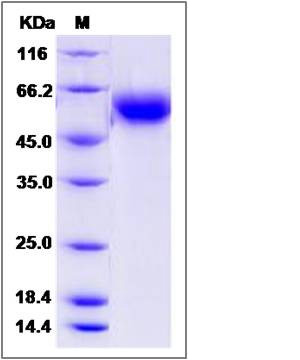Human BPIFB1 / LPLUNC1 Protein (His Tag)
C20orf114,LPLUNC1
- 100ug (NPP1937) Please inquiry
| Catalog Number | P13275-H08H |
|---|---|
| Organism Species | Human |
| Host | Human Cells |
| Synonyms | C20orf114,LPLUNC1 |
| Molecular Weight | The recombinant human BPIFB1 consists of 474 amino acids and predicts a molecular mass of 51.7 KDa. It migrates as an approximately 53 KDa band in SDS-PAGE under reducing conditions. |
| predicted N | Thr 22 |
| SDS-PAGE |  |
| Purity | > 95 % as determined by SDS-PAGE |
| Protein Construction | A DNA sequence encoding the human BPIFB1 (AAH08429.1) (Met1-Gln484) was expressed with a polyhistidine tag at the C-terminus. |
| Bio-activity | |
| Research Area | |
| Formulation | Lyophilized from sterile PBS, pH 7.4. 1. Normally 5 % - 8 % trehalose and mannitol are added as protectants before lyophilization. Specific concentrations are included in the hardcopy of COA. |
| Background | BPIFB1, also known as LPLUNC1, belongs to the BPI/LBP/Plunc superfamily, plunc family. BPIFB1 may be involved in the innate immune response to bacterial exposure in the mouth, nasal cavities, and lungs. BPIFB1 is expressed in the upper respiratory tract and oral cavity, which may function in host defence. The expression of BPIF proteins is associated with CF lung disease in humans and mice. It is unclear if this elevation of protein production, which results from phenotypic alteration of the cells within the diseased epithelium, plays a role in the pathogenesis of the disease. BPIFB1 is an abundant, secreted product of goblet cells and minor mucosal glands of the respiratory tract and oral cavity and suggest that the protein functions in the complex milieu that protects the mucosal surfaces in these locations. |
| Reference |
